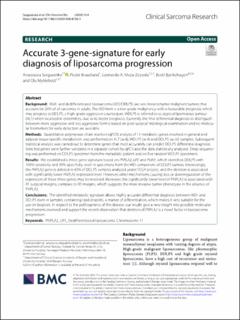| dc.contributor.author | Serguienko, Anastassia | |
| dc.contributor.author | Braadland, Peder Rustøen | |
| dc.contributor.author | Meza-Zepeda, Leonardo A. | |
| dc.contributor.author | Bjerkehagen, Bodil | |
| dc.contributor.author | Myklebost, Ola | |
| dc.date.accessioned | 2021-06-14T07:42:11Z | |
| dc.date.available | 2021-06-14T07:42:11Z | |
| dc.date.created | 2021-02-17T17:56:44Z | |
| dc.date.issued | 2020 | |
| dc.identifier.issn | 2045-3329 | |
| dc.identifier.uri | https://hdl.handle.net/11250/2759173 | |
| dc.description.abstract | Background
Well- and dedifferentiated liposarcoma (WD/DDLPS) are rare mesenchymal malignant tumors that account for 20% of all sarcomas in adults. The WD form is a low-grade malignancy with a favourable prognosis which may progress to DDLPS, a high-grade aggressive counterpart. WDLPS is referred to as atypical lipomatous tumour (ALT) when localised in extremities, due to its better prognosis. Currently the final differential diagnosis to distinguish between more aggressive and less aggressive form is based on post-surgical histological examination and no molecular biomarkers for early detection are available.
Methods
Quantitative polymerase chain reaction (qPCR) analysis of 11 metabolic genes involved in general and adipose tissue-specific metabolism, was performed on ALT (= 8), WDLPS (= 9) and DDLPS (= 20) samples. Subsequent statistical analysis was carried out to determine genes that most accurately can predict DDLPS differential diagnosis. Selected genes were further validated in a separate cohort by qPCR and the data statistically analysed. Deep sequencing was performed on DDLPS specimen from the metastatic patient and on five random WDLPS specimens.
Results
We established a three-gene signature based on PNPLA2, LIPE and PLIN1, which identified DDLPS with 100% sensitivity and 90% specificity, even in specimens from the WD component of DDLPS tumors. Interestingly, the PNPLA2 gene is deleted in 45% of DDLPS samples analyzed under TCGA project, and the deletion is associated with significantly lower PNPLA2 expression level. However, other mechanisms causing loss or downregulation of the expression of these three genes may be involved. Moreover, the significantly lower level of PNPLA2 is associated with R1 surgical margins, compare to R0 margins, which suggests the more invasive tumor phenotype in the absence of PNPLA2.
Conclusions
The identified metabolic signature allows highly accurate differential diagnosis between WD- and DDLPS even in samples containing lipid droplets, a marker of differentiation, which makes it very suitable for the use on biopsies. In respect to the pathogenesis of the disease, our results give a new insight into possible molecular mechanisms involved and support the recent observation that deletion of PNPLA2 is a novel factor in liposarcoma progression. | en_US |
| dc.language.iso | eng | en_US |
| dc.publisher | BMC | en_US |
| dc.rights | Navngivelse 4.0 Internasjonal | * |
| dc.rights.uri | http://creativecommons.org/licenses/by/4.0/deed.no | * |
| dc.title | Accurate 3-gene-signature for early diagnosis of liposarcoma progression | en_US |
| dc.type | Journal article | en_US |
| dc.type | Peer reviewed | en_US |
| dc.description.version | publishedVersion | en_US |
| dc.rights.holder | Copyright The Author(s) 2020 | en_US |
| dc.source.articlenumber | 4 | en_US |
| cristin.ispublished | true | |
| cristin.fulltext | original | |
| cristin.qualitycode | 1 | |
| dc.identifier.doi | 10.1186/s13569-020-0126-1 | |
| dc.identifier.cristin | 1891081 | |
| dc.source.journal | Clinical Sarcoma Research | en_US |
| dc.relation.project | Helse Sør-Øst RHF: 2013012 | en_US |
| dc.identifier.citation | Clinical Sarcoma Research. 2020, 10, 4. | en_US |
| dc.source.volume | 10 | en_US |

